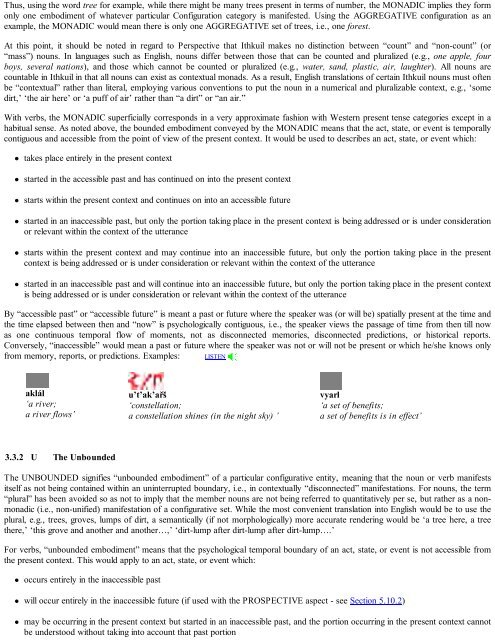logical language - Developers
logical language - Developers
logical language - Developers
You also want an ePaper? Increase the reach of your titles
YUMPU automatically turns print PDFs into web optimized ePapers that Google loves.
Thus, using the word tree for example, while there might be many trees present in terms of number, the MONADIC implies they form<br />
only one embodiment of whatever particular Configuration category is manifested. Using the AGGREGATIVE configuration as an<br />
example, the MONADIC would mean there is only one AGGREGATIVE set of trees, i.e., one forest.<br />
At this point, it should be noted in regard to Perspective that Ithkuil makes no distinction between “count” and “non-count” (or<br />
“mass”) nouns. In <strong>language</strong>s such as English, nouns differ between those that can be counted and pluralized (e.g., one apple, four<br />
boys, several nations), and those which cannot be counted or pluralized (e.g., water, sand, plastic, air, laughter). All nouns are<br />
countable in Ithkuil in that all nouns can exist as contextual monads. As a result, English translations of certain Ithkuil nouns must often<br />
be “contextual” rather than literal, employing various conventions to put the noun in a numerical and pluralizable context, e.g., ‘some<br />
dirt,’ ‘the air here’ or ‘a puff of air’ rather than “a dirt” or “an air.”<br />
With verbs, the MONADIC superficially corresponds in a very approximate fashion with Western present tense categories except in a<br />
habitual sense. As noted above, the bounded embodiment conveyed by the MONADIC means that the act, state, or event is temporally<br />
contiguous and accessible from the point of view of the present context. It would be used to describes an act, state, or event which:<br />
takes place entirely in the present context<br />
started in the accessible past and has continued on into the present context<br />
starts within the present context and continues on into an accessible future<br />
started in an inaccessible past, but only the portion taking place in the present context is being addressed or is under consideration<br />
or relevant within the context of the utterance<br />
starts within the present context and may continue into an inaccessible future, but only the portion taking place in the present<br />
context is being addressed or is under consideration or relevant within the context of the utterance<br />
started in an inaccessible past and will continue into an inaccessible future, but only the portion taking place in the present context<br />
is being addressed or is under consideration or relevant within the context of the utterance<br />
By “accessible past” or “accessible future” is meant a past or future where the speaker was (or will be) spatially present at the time and<br />
the time elapsed between then and “now” is psycho<strong>logical</strong>ly contiguous, i.e., the speaker views the passage of time from then till now<br />
as one continuous temporal flow of moments, not as disconnected memories, disconnected predictions, or historical reports.<br />
Conversely, “inaccessible” would mean a past or future where the speaker was not or will not be present or which he/she knows only<br />
from memory, reports, or predictions. Examples: LISTEN<br />
aklál<br />
‘a river;<br />
a river flows’<br />
3.3.2 U The Unbounded<br />
u’t’ak’ařš<br />
‘constellation;<br />
a constellation shines (in the night sky) ’<br />
vyarl<br />
‘a set of benefits;<br />
a set of benefits is in effect’<br />
The UNBOUNDED signifies “unbounded embodiment” of a particular configurative entity, meaning that the noun or verb manifests<br />
itself as not being contained within an uninterrupted boundary, i.e., in contextually “disconnected” manifestations. For nouns, the term<br />
“plural” has been avoided so as not to imply that the member nouns are not being referred to quantitatively per se, but rather as a nonmonadic<br />
(i.e., non-unified) manifestation of a configurative set. While the most convenient translation into English would be to use the<br />
plural, e.g., trees, groves, lumps of dirt, a semantically (if not morpho<strong>logical</strong>ly) more accurate rendering would be ‘a tree here, a tree<br />
there,’ ‘this grove and another and another…,’ ‘dirt-lump after dirt-lump after dirt-lump….’<br />
For verbs, “unbounded embodiment” means that the psycho<strong>logical</strong> temporal boundary of an act, state, or event is not accessible from<br />
the present context. This would apply to an act, state, or event which:<br />
occurs entirely in the inaccessible past<br />
will occur entirely in the inaccessible future (if used with the PROSPECTIVE aspect - see Section 5.10.2)<br />
may be occurring in the present context but started in an inaccessible past, and the portion occurring in the present context cannot<br />
be understood without taking into account that past portion


